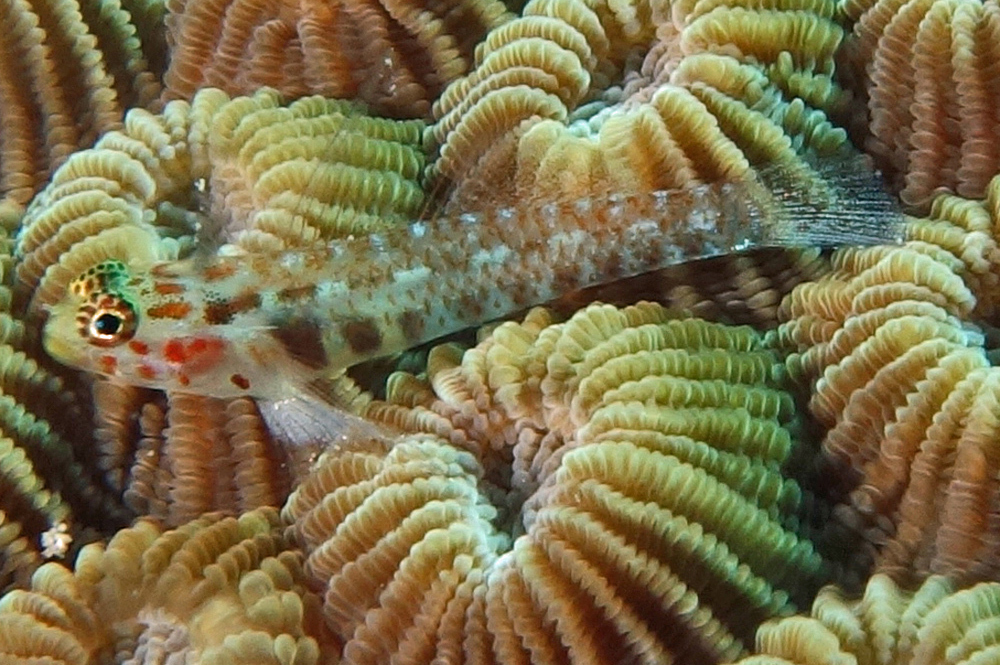Headspot Eviota, Eviota melasma Lachner & Karnella 1980
Other Names: Black-spotted Pygmy-goby, Headspot Dwarfgoby, Headspot Pygmygoby, Melasma Pygmy Goby

A Headspot Eviota, Eviota melasma, at Pidgin Point, Lizard Island, Great Barrier Reef, Queensland, November 2018. Source: Lyle Vail via Anne Hoggett / iNaturalist.org. License: CC By Attribution-NonCommercial
Summary:
A semi-transparent pygmygoby with irregular reddish-brown internal bars along the body, a black spot (of varying intensities) above the gill opening, irregular reddish blotches on the nape, red spots on the cheek, 3 reddish blotches separated by white to yellowish bars on the belly, and a narrow white band on the pectoral-fin base.
Cite this page as:
Bray, D.J. 2020, Eviota melasma in Fishes of Australia, accessed 02 Jul 2025, https://fishesofaustralia.net.au/home/species/1351
Headspot Eviota, Eviota melasma Lachner & Karnella 1980
More Info
|
Distribution |
Ashmore Reef and surrounding reefs in the Timor Sea, and the Houtman Abrolhos, Western Australia, to One Tree Island, Queensland, and reefs in the Coral Sea; also Cocos (Keeling) Islands in the eastern Indian Ocean. Elsewhere the species occurs in the tropical, east-Indo-west-central Pacific: from the Cocos (Keeling) Islands throughout the East Indies, east to Samoa and New Caledonia, south to Australia; north to the Yaeyama Islands of Japan and east to Micronesia. Inhabits coastal and offshore reefs, including reef slopes, spur and groove, patch reefs, sand slopes and rocky substrates. |
|
Features |
Dorsal fin VI + I, 8-10; Anal fin I, 8-9; Pectoral fin 15-18, 10th-16th rays branched; Longitudinal scale series 23-25. Scales ctenoid, absent on head and breast; separated pelvic fins, thin membrane joining bases; depth of body 6.5-7.7 in SL. |
|
Etymology |
The specific name melasma is from the Greek melasma (= black spot), in reference to the dark spot on each side of the top of the head. |
|
Species Citation |
Eviota melasma Lachner & Karnella 1980, Smithson. Contrib. Zool. 315: 27, figs 8c- d, 9b, 10. Type locality: Endeavour Reef, Queensland. |
|
Author |
Bray, D.J. 2020 |
|
Resources |
Headspot Eviota, Eviota melasma Lachner & Karnella 1980
References
Allen, G.R. 1993. Fishes of Ashmore Reef and Cartier Island. Records of the Western Australian Museum, Supplement 44: 67-91.
Allen, G.R. & Erdmann, M.V. 2012. Reef fishes of the East Indies. Perth : Tropical Reef Research 3 vols, 1260 pp.
Allen, G.R. & Smith-Vaniz, W.F. 1994. Fishes of Cocos (Keeling) Islands. Atoll Research Bulletin 412: 1-21.
Depczynski, M. & Bellwood, D.R. 2005. Wave energy and spatial variability in community structure of small cryptic coral reef fishes. Marine Ecology Progress Series 303: 283-293
Depczynski, M. & Bellwood, D.R. 2006. Extremes, plasticity, and invariance in vertebrate life history traits: insights from coral reef fishes. Ecology 87(12): 3119-3127.
Greenfield, D.W. 2017. An overview of the dwarfgobies, the second most speciose coral-reef fish genus (Teleostei: Gobiidae: Eviota). Journal of the Ocean Science Foundation 29: 32-54. http://dx.doi.org/10.5281/zenodo.1115683
Greenfield, D., Larson, H. & Williams, J.T. 2016. Eviota melasma. The IUCN Red List of Threatened Species 2016: e.T193237A2212856. http://dx.doi.org/10.2305/IUCN.UK.2016-3.RLTS.T193237A2212856.en. Downloaded on 04 June 2019.
Greenfield, D.W. & Randall, J.E. 2016. A review of the dwarfgobies of Fiji, including descriptions of five new species (Teleostei: Gobiidae: Eviota). Journal of the Ocean Science Foundation 20: 25-75. PDF Open access
Greenfield, D.W. & Winterbottom, R. 2016. A key to the dwarfgoby species (Teleostei: Gobiidae: Eviota) described between 1871 and 2016. Journal of the Ocean Science Foundation 24: 35–90. doi: http://dx.doi.org/10.5281/zenodo.219620 Open access
Hobbs, J-P.A., Newman, S .J., Mitsopoulos, G.E.A., Travers, M.J., Skepper, C.L., Gilligan, J.J., Allen, G.R., Choat, H.J. & Ayling, A.M. 2014. Fishes of the Cocos (Keeling) Islands: new records, community composition and biogeographic significance. Raffles Bulletin of Zoology Supplement 30: 203–219
Hutchins, J.B. 1994. A survey of the nearshore reef fish fauna of Western Australia's west and south coasts — The Leeuwin Province. Records of the Western Australian Museum, Supplement 46: 1-66 figs 1-6
Lachner, E.A. & Karnella, S.J. 1980. Fishes of the Indo-Pacific genus Eviota with descriptions of eight new species (Teleostei : Gobiidae). Smithsonian Contributions to Zoology 315: 1-127 figs 1-66 https://doi.org/10.5479/si.00810282.315
Larson, H.K., Williams, R.S. & Hammer, M.P. 2013. An annotated checklist of the fishes of the Northern Territory, Australia. Zootaxa 3696(1): 1-293.
Myers, R.F. 1999. Micronesian Reef Fishes. A comprehensive guide to the coral reef fishes of Micronesia. Guam : Coral Graphics vi 330 pp. 192 pls.
Randall, J.E., Allen, G.R. & Steene, R. 1997. Fishes of the Great Barrier Reef and Coral Sea. Bathurst : Crawford House Press 557 pp. figs.
Russell, B.C. 1983. Annotated checklist of the coral reef fishes in the Capricorn-Bunker group, Great Barrier Reef, Australia. Great Barrier Reef Marine Park Authority. Special Publication Series 1: 1-184 figs 1-2






